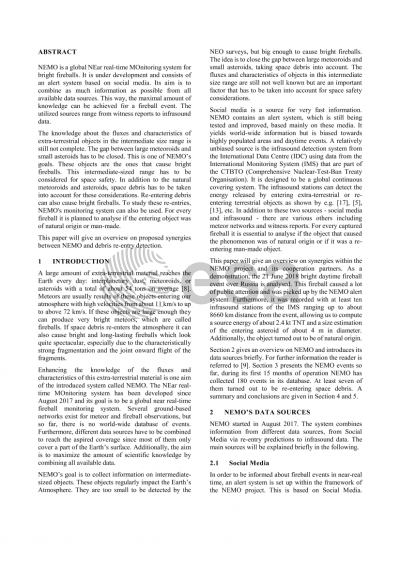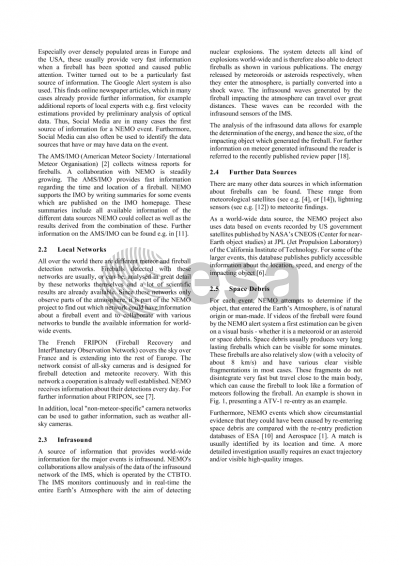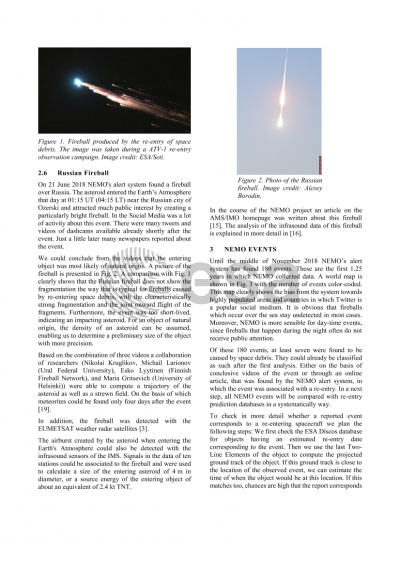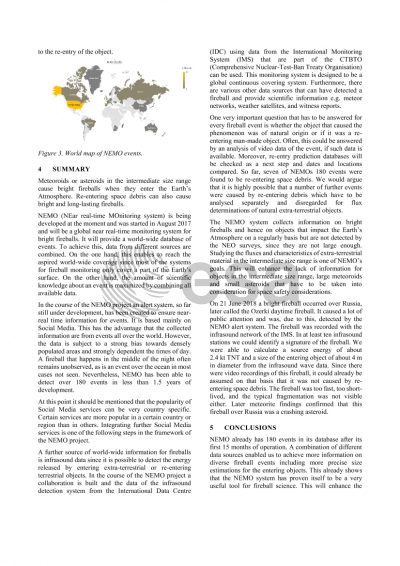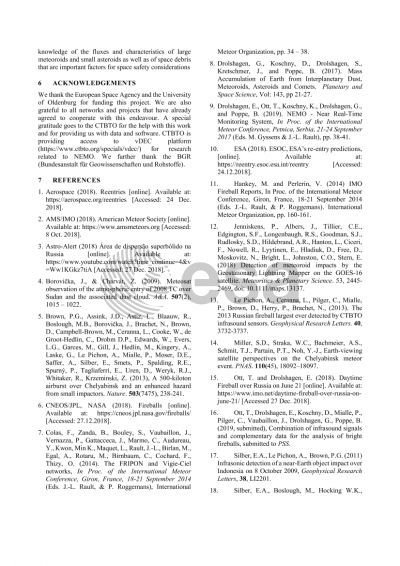Document details

Abstract
A large amount of extra-terrestrial material reaches the Earth every day: interplanetary dust, meteoroids, or asteroids with a total of about 54 tons on average (Drolshagen et al. 2017). Meteors are usually results of these objects entering our atmosphere with high velocities of up to 72 km/s. If these objects are large enough they can produce very bright meteors, which we call fireballs. If space debris re-enters it can also cause bright and long-lasting fireballs which look quite spectacular.
Enhancing the knowledge of the fluxes and characteristics of this extra-terrestrial material is one aim of our system, which we call NEMO. The NEar real-time MOnitoring system is being developed since August 2017 and will be a global near real-time fireball monitoring system. Several ground-based networks exist for meteor and fireball observations, but so far, there is no world-wide database of events. Furthermore, different data sources have to be combined to reach the aspired coverage since most of them only cover a part of the Earth surface. Additionally, by combining as much data as possible the amount of scientific knowledge is maximized.
NEMOs goal is to collect information on objects that regularly impact the Earth atmosphere, are too small to be detected by the NEO surveys, cause bright fireballs, and hence, to close the gap between large meteoroids and small asteroids, taking space debris into account. The fluxes and characteristics of objects in this intermediate size range are still not well known, but are an important factor that has to be taken into account for space safety considerations.
Social media is a source for very fast information. NEMO contains an alert system, in test-operation mode so far, based mainly on these media. It yields world-wide information but is biased to highly populated areas and daytime events. A relatively unbiased source is the infrasound detection system from the International Data Centre (IDC) using data from the International Monitoring System (IMS) that are part of the CTBTO (Comprehensive Nuclear Test Ban Treaty Organisation). In its final development stage, it will cover the whole Earth during day and night. The infrasound stations can detect the energy released by entering extra-terrestrial or re-entering terrestrial objects as shown by e.g. Silber et al. (2011), Brown et al. (2013), Le Pichon et al. (2013), etc. In addition to these two sources - social media and infrasound - there are various others including meteor networks and witness reports. For every captured fireball it is essential to analyse if the object that caused the phenomenon was of natural origin or if it was a re-entering man-made object.
Our talk will give an overview on NEMO and its detection procedure. On 21 June 2018 there was a bright daytime fireball over Russia. This fireball caused a lot of public attention and was picked up by the NEMO alert system. Furthermore, it was recorded with at least ten infrasound stations of the IMS, allowing us to compute a source energy of about 2.4 kt TNT and a size estimation of the entering asteroid of about 4 m in diameter. Additionally, the object turned out to be of natural origin. This Russian fireball and its analysis will be presented in more detail in this talk.
The project is a cooperation between the CTBTO, ESA, BGR, and the University of Oldenburg.
Acknowledgements
We thank the European Space Agency and the University of Oldenburg for funding this project. We also thank all organisations, networks and projects that have already agreed to cooperate with this endeavour.
This work was made possible by the Virtual Data Exploitation Centre (vDEC - https://www.ctbto.org/specials/vdec/) platform of the CTBTO that allows access to IMS data for civil and scientific applications.
References
Drolshagen, G., Koschny, D., Drolshagen, S., Kretschmer, J., and Poppe, B. (2017) Mass Accumulation of Earth from Interplanetary Dust, Meteoroids, Asteroids and Comets, Planetary and Space Science, Vol: 143, pages 21-27
Brown, P. G., et al. (2013), A 500-kiloton airburst over Chelyabinsk and an enhanced hazard from small impactors, Nature. 2013 Nov 14;503(7475):238-41
Le Pichon, A., Ceranna, L., Pilger, C., Mialle, P., Brown, D., Herry, P., Brachet, N., (2013), The 2013 Russian fireball largest ever detected by CTBTO infrasound sensors, Geophysical Research Letters, VOL. 40, 3732-3737
Silber, E. A., Le Pichon, A., Brown, P. G. (2011) Infrasonic detection of a near‐Earth object impact over Indonesia on 8 October 2009, Geophysical Research Letters, VOL. 38, LI2201
Preview

